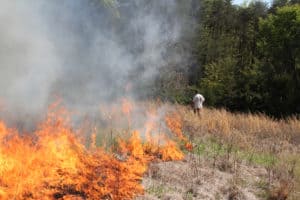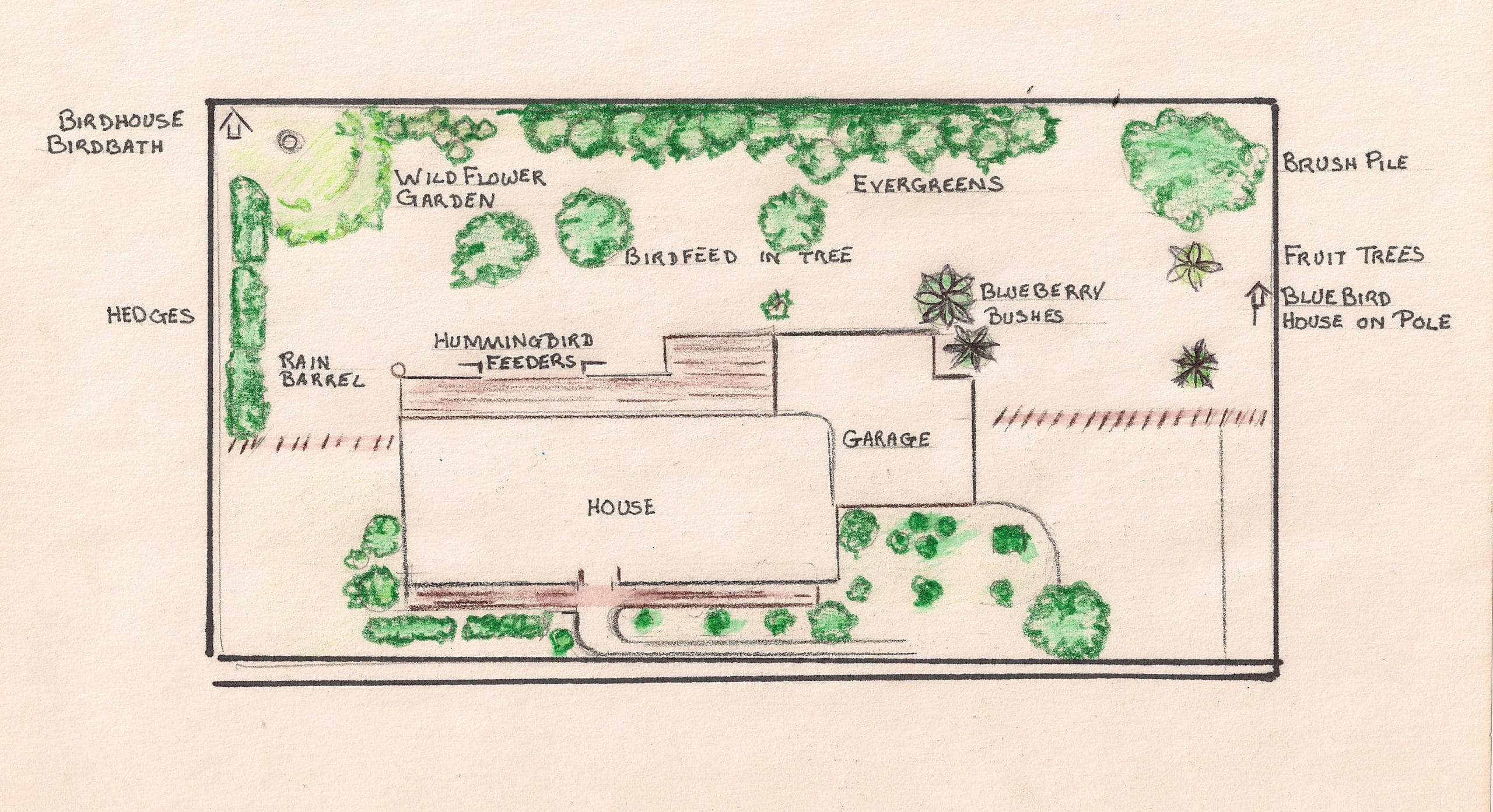by David Hart
Creating high-quality habitat is not always easy, but the rewards are well worth the effort.

Timber thinning is a great way to boost the productivity of your land. Removing some trees allows sunlight to reach the ground, which stimulates new plant growth. Leave the mast-bearing trees like oaks and hickories.
When Steve Dixon signed the papers on 165 acres in central Virginia, he figured he bought a piece of deer and turkey hunting heaven. The property consisted of a mix of mature trees and fields that were cut for hay, along with a small food plot tucked into a corner along a creek.
“I hardly saw any deer the first season I hunted it, and turkeys were scarce, too,” recalls the semi-retired financial planner. “I had no idea what was wrong.”
That was 10 years ago. As it turned out, the land was in poor shape. Since then, Dixon has worked on the land at every opportunity. He planted borders along the fields, he killed off the plants that provided no benefit to wildlife, and he managed the timber.
“The deer hunting has gotten much better. So has the turkey hunting,” he says.
“I’ve even seen some quail, and there are a lot more rabbits.”
Seek Help
Dixon’s first step was to call a state wildlife biologist. Although many biologists don’t have time to visit with every landowner looking for help, most will at least offer some technical guidance.
“We talked for about 30 minutes. He offered some general guidelines on how I could improve the land,” recalls Dixon. “I did most of the work myself. I also hired professionals to do the things I couldn’t.”
Hired help included a logger to conduct some timber management. A mature forest looks pretty, but it can be a wildlife desert. Aside from acorns dropped by oaks, there isn’t much food available growing beneath the closed canopy of a mature forest. Cutting some or all the trees in parts of the forest allows sunlight to reach the ground, which stimulates a flood of native grasses, shrubs and vines. This new growth not only provides a plethora of food, but it creates abundant cover for a variety of game and non-game species of animals and birds.
Dixon conducted a couple of small clear-cuts, where all the trees were removed, and he did a select cut, where only specific trees were taken out, on a large part of his forest. He made some money, and he increased the amount of wildlife he saw, as well.
“It took less than a year for all this new stuff to start growing. It was pretty amazing how fast the deer started using it,” he recalls. “A couple of years later, I had quail and turkeys nesting in the thick cover.”
Diversity Is Key
Dixon didn’t stop with timber management. He also put a lot of time and effort into improving his fields. An avid deer hunter, he knew the current state of his fields held little appeal to deer and other wildlife.

Controlled burning is a great way to stimulate new plant growth while clearing out accumulated dead plant matter. It’s an outstanding tool for quail habitat management and deer benefit from fire, too.
“They were mostly fescue, which doesn’t provide any benefit to deer, quail or turkeys. It’s just about useless,” he says.
He hired his local farmer’s cooperative to spray the field with a selective herbicide that killed the grass. It didn’t take long for an entire new plant community to grow. Ragweed, beggar’s lice, a host of wildflowers and some native grasses sprang up.
“I started seeing a lot more deer during hunting season, and there are turkeys nesting on the property, too,” he says. “I originally put all my money into a couple of food plots, but they only do so much.”
What really matters, says Dixon, is having a diversity of habitat, including everything from thick, brushy field edges to mature, mast-bearing trees in the forest.
“The more variety you have, the better your land will be for all types of wildlife,” says Dixon.
Think Small
You don’t have to own 165 acres or even 16 acres to give wildlife a helping hand. Anyone, even those with a postage stamp suburban lot, can do something. Dixon actually improved the habitat in his own suburban yard.
“I encouraged the back edge of my yard to grow up into weeds and vines. Basically, I didn’t mow it or otherwise try to control anything unless I knew it was a non-native plant. I know a lot of people don’t like seeing stuff like that, but I see all kinds of birds and other wildlife,” he says. “Most other yards are virtually void of any wildlife.”
He increased the appeal of his yard by planting flowers and fruit-bearing shrubs that not only look attractive, but that provide food for birds and pollinating insects.
None of it was easy, admits Dixon, and it isn’t necessarily inexpensive, either.
“Once I started seeing the results, I realized it was all worth it,” he says. “In hindsight, I didn’t do it so I would have better hunting. I did it because I wanted to help wildlife. Better hunting just happened to be a by-product of the work I did.”
5 Wildlife Enhancers For The Yard

With just a minimum of effort, small-scale improvements around the house can lead to rewarding wildlife-viewing experiences, or just in knowing you are doing your part to help.
With just a minimum of effort, small-scale improvements around the house can lead to rewarding wildlife-viewing experiences, or just in knowing you are doing your part to help. Sportsmen have a weakness for wanting to help wildlife, and what better place to nurture our nurturing instincts than right in our own backyards?
Here are five tips for making the most of your backyard habitat:
- Feed the Birds, Embrace the Squirrels: I was once a frustrated feeder of birds. I tried about every fancy “squirrel-proof” bird feeder and grandma trick I could find, but to no avail. I truly believe my backyard squirrels quite enjoyed the torture they delivered. Now I (almost) embrace the squirrels. I even fool myself into thanking them for the job they do of spreading the bird feed on the ground so more birds can enjoy. I like to feed the birds, and yes it feeds other animals (chiefly squirrels), too. Use a reputable brand of birdseed—I prefer Pennington mixes that include black oil sunflowers. And use a feeder that is covered to keep the feed dry. Moldy seed could harm or even kill birds.
- Brushpiles Are Golden: It took all of my charm to convince my wife that the pile of limbs and shrubbery clippings along the back line of our yard was an example of my kind heart and not laziness. Brushpiles may be the easiest improvement a homeowner can make for backyard habitat, and brushpiles may also be the most beneficial. All kinds of critters and birds love my brushpiles.
- Blooms Beget Berries: Flowering bushes, shrubs and trees are pretty. While your neighbors and houseguests will be duly impressed with the flowering displays of spring, your local animals and birds will love you in the late summer and fall when those blooms become berries. Some of these berries you’ll enjoy yourself—just save a few for the wildlife! Good choices for bushes are blackberries, raspberries and blueberries. Dogwood trees beautify any yard with spring blooms, and the red dogwood berries of fall are a favorite food for most birds and animals. Fruit trees are another great option. Pear trees are generally easier to grow, while apple trees are fantastic but can be a bit sensitive to soil types and climate.
- Tiny Houses For Everyone: There are birdhouses, and there are specialized birdhouses for specific flavors of birds. I recommend placing some specific birdhouses around the edges of your yard. A wren nest box, a bluebird box, a chickadee next box, and a bat house (yes, a bat house!) are specific birdhouses to consider. And then maybe include a generic birdhouse—just don’t be surprised to raise a family of cowbirds.
- Evergreens For Winter: The winter woods are bare, and likely so is the wildlife habitat in your yard. Consider adding some plantings that create important wintertime cover for birds and animals. Good choices (check with your local nursery about species that do well in your area) include rhododendron, eastern hemlocks, cedars and pines.
The Union Sportsmen’s Alliance website is designed to provide valuable articles about hunting, fishing and conservation for members of AFL-CIO affiliated labor unions and all sportsmen and sportswomen who appreciate hunting and fishing and want to preserve our outdoor heritage for future generations. If you would like your own story and experience from the outdoors to be considered for our website, please email us at [email protected].



